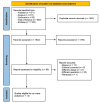Comparative Safety and Efficacy of Roux-en-Y Gastric Bypass Versus One-Anastomosis Gastric Bypass: A Systematic Review and Meta-Analysis of Randomized Clinical Trials
- PMID: 39525233
- PMCID: PMC11549682
- DOI: 10.7759/cureus.71193
Comparative Safety and Efficacy of Roux-en-Y Gastric Bypass Versus One-Anastomosis Gastric Bypass: A Systematic Review and Meta-Analysis of Randomized Clinical Trials
Abstract
Obesity has become a global epidemic, affecting both developed and developing nations. Despite extensive efforts, historical outcomes of medical interventions for obesity have been unsatisfactory. Bariatric surgeries, including sleeve gastrectomy (SG) and laparoscopic Roux-en-Y gastric bypass (RYGB), are now recognized as the primary treatment for severe obesity. However, laparoscopic one-anastomosis gastric bypass (OAGB) has emerged as a promising alternative, offering simplified procedures compared to RYGB. While OAGB's initial outcomes are optimistic, concerns about biliary reflux persist. Our systematic review aims to compare the safety and efficacy outcomes of RYGB and OAGB to inform clinical decision-making in managing obesity. We searched five databases up to February 2024. We included randomized controlled trials (RCTs) comparing RYGB and OAGB in obese patients, focusing on safety and efficacy outcomes. Data extraction covered study details, participant demographics, interventions, and outcomes related to operative details, complications, follow-up results, and weight changes. The risk of bias was assessed using the Cochrane tool. The analysis involved risk ratios for dichotomous data and mean differences for continuous data, using fixed or random effects models based on heterogeneity. Analyses were performed with Review Manager software v5.4. A total of 1057 patients were included in the analysis, sourced from 12 distinct RCTs. The analysis indicated OAGB outperformed RYGB in BMI reduction (MD = -0.69, p = 0.005), whereas RYGB was more effective in excess weight loss (MD = 6.51, p < 0.0001) and excess BMI loss (MD = 3.91, p < 0.0001). OAGB led to shorter operation times (MD = -34.89 minutes, p < 0.0001) and shorter periods of hospital stays (MD = -0.27 days, p = 0.01), along with fewer overall complications (RR = 0.58, p = 0.02) and lower incidence of upper gastrointestinal endoscopy complications (RR = 2.98, p = 0.0001). On the other hand, RYGB showed higher remission rates for dyslipidemia (RR = 0.60, p = 0.0003) and higher remissions of hypertension (RR = 0.83, p = 0.04). The majority of results were homogenous. Both OAGB and RYGB have their respective advantages and limitations. OAGB appears to offer benefits in terms of operation efficiency and early postoperative recovery, making it a potentially preferable option for patients and surgeons focused on these aspects. On the other hand, RYGB might be more suitable for patients prioritizing long-term weight loss and remission of certain comorbidities like hypertension. Ultimately, the choice between OAGB and RYGB should be made on an individual basis, considering the specific needs, conditions, and goals of each patient.
Keywords: bariatric surgery; obesity; one-anastomosis gastric bypass; roux-en-y gastric bypass; systematic review and meta analysis.
Copyright © 2024, Elsaigh et al.
Conflict of interest statement
Conflicts of interest: In compliance with the ICMJE uniform disclosure form, all authors declare the following: Payment/services info: All authors have declared that no financial support was received from any organization for the submitted work. Financial relationships: All authors have declared that they have no financial relationships at present or within the previous three years with any organizations that might have an interest in the submitted work. Other relationships: All authors have declared that there are no other relationships or activities that could appear to have influenced the submitted work.
Figures


















References
-
- The complications of overweight and obesity according to obesity indicators (body mass index and waist circumference values) in a population of Tangier (northern Morocco): a cross-sectional study. Hamjane N, Benyahya F, Mechita MB, Nourouti NG, Barakat A. Diabetes Metab Syndr. 2019;13:2619–2624. - PubMed
-
- Orlistat: a review of its use in the management of obesity. Hvizdos KM, Markham A. Drugs. 1999;58:743–760. - PubMed
-
- Gastrointestinal surgery for severe obesity. https://pubmed.ncbi.nlm.nih.gov/1760489/ Consens Statement. 1991;9:1–20. - PubMed
Publication types
LinkOut - more resources
Full Text Sources
Research Materials
